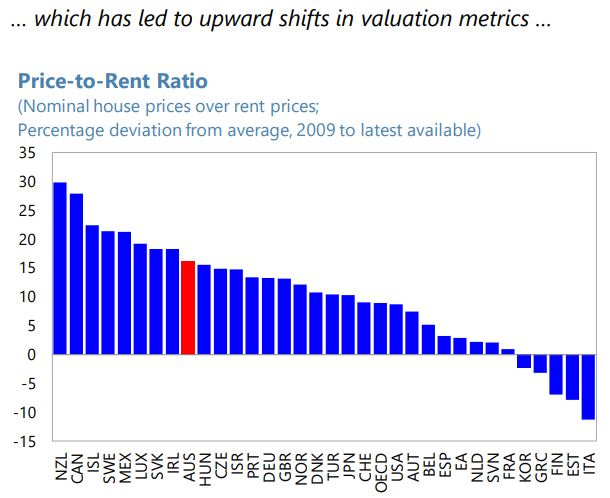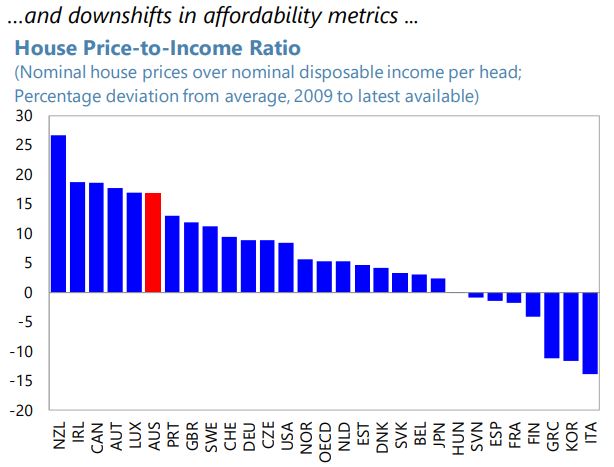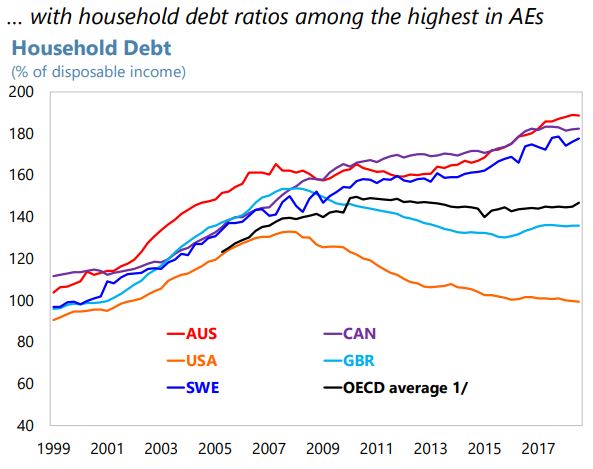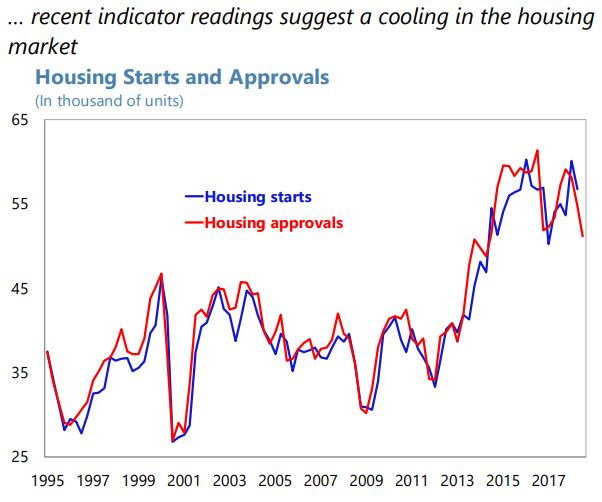Friday, February 22, 2019
Housing Market in Australia
From the IMF’s latest report on Australia:
“The housing market correction is helping housing affordability. Foreign and domestic investor demand has moderated, thereby enhancing opportunities for first-time home buyers and purchases by owner-occupiers more broadly. On the supply side, progress has been made in using City Deals, agreements across all levels of government that integrate planning and infrastructure delivery for new developments and redevelopments. A prominent example―the City Deal for western Sydney―encompasses the development of the urban area around the new airport. Two states (Western Australia and Tasmania) introduced or announced housing-related tax policy measures discriminating between residents and non-residents since the last Article IV Consultation.
Housing supply reforms will remain critical to restoring housing affordability. While the housing market correction will help, it is unlikely to be sufficient for inclusive, broad-based affordability and growth. The underlying demand for housing is widely expected to remain strong with a robust economic growth outlook for and high population growth in urban areas. At the same time, broad affordability will also be a precondition for a significant reduction in related macro-financial vulnerabilities. As planning, zoning, and other reforms affect supply and prices with long lags, housing supply reforms should, therefore, not be delayed because of the housing market correction. City Deals are a useful catalyst for the large-scale development or redevelopment of urban areas. Nevertheless, this instrument has limited reach, although the Regional Deals envisaged by the government would provide for a welcome extension. Some states should still take the opportunity for further streamlining and consolidation in planning and zoning regulation.
Broader tax reforms that also address housing and land use would reinforce the impact of supply-side measures. Stamp duties should be replaced by broader land taxes, which would strengthen incentives for efficient land use. Within the context of a broader tax reform, gradual lowering of capital gains discounts and limits on negative gearing for investors would reduce structural incentives for leveraged investment by households, including in residential real estate. A more limited capital gains tax exemption for owner-occupiers should also be considered.
The housing policy measures discriminating nonresident buyers should be reconsidered. As the role of foreign buyers in residential real estate markets has started to decline, the discriminatory measures should be reconsidered, as they may no longer be needed to address housing market imbalances. They should be replaced by alternative and effective non-discriminatory measures where possible (e.g., a general surcharge on all vacant property).
The state governments of New South Wales and Victoria noted that the fall in housing prices in Sydney and Melbourne was larger than originally projected in their budgets. Nevertheless, despite their limited progress on zoning and planning reform to reduce impediments to housing supply and affordability, they expected house prices to find support from both housing demand and supply factors. The authorities highlighted that City Deals could be important tools to foster urban housing supply. City Deals have allowed all levels of government to coordinate planning and construction decisions, thereby facilitating infrastructure provision which can in turn support housing supply expansion. Deals agreed on or announced in 2018 included Darwin, Geelong, Hobart, and Perth. There are also plans underway to pilot Regional Deals outside of the major urban areas.”
From the IMF’s latest report on Australia:
“The housing market correction is helping housing affordability. Foreign and domestic investor demand has moderated, thereby enhancing opportunities for first-time home buyers and purchases by owner-occupiers more broadly. On the supply side, progress has been made in using City Deals, agreements across all levels of government that integrate planning and infrastructure delivery for new developments and redevelopments. A prominent example―the City Deal for western Sydney―encompasses the development of the urban area around the new airport.
Posted by at 10:59 AM
Labels: Global Housing Watch
Housing View – February 22, 2019
On cross-country:
- Peter Praet: On the importance of real estate statistics – European Central Bank
On the US:
- Housing Is Already in a Slump. So It (Probably) Can’t Cause a Recession. – New York Times
- Despite contrary claims, African-Americans believe in the American dream — even millennials – American Enterprise Institute
- Oregon’s Rent Control Bill Would Ultimately Please Nobody – Cato Institute
- HUD Funding Bill Will Launch Housing Voucher Mobility Demonstration – Center on Budget and Policy Priorities
- Housing investment, sea level rise, and climate change beliefs – Economic Letters
- “Debtless” Housing Boom Leads Household Wealth Recovery – Federal Reserve Bank of St. Louis
- A Red-State Take on a YIMBY Housing Bill – Citylab
- Why Unions Must Bargain for Affordable Housing—and How – American Prospect
- Without Amazon HQ2, What Happens to Housing in Queens? – Citylab
- The Super Bowl: Key Housing Indicator – NPR
- Yet another sign from the housing market of a looming recession – HousingWire
- A Shortage of Short Sales: Explaining the Underutilization of a Foreclosure Alternative – Federal Reserve Bank of Philadelphia
- Recession not likely before 2021, housing economists say – The Orange County Register
- The Federal Shutdown Damaged Housing Voucher Programs – American Prospect
On other countries:
- [Australia] The Housing Slump Down Under Is Getting Serious – Bloomberg
- [Canada] Montreal’s Real-Estate Market Is About to Eclipse Vancouver’s – Bloomberg
- [China] The Effect of a Subway on House Prices: Evidence from Shanghai – Real Estate Economics
- [China] China Property ‘Stealth Easing’ Spreads in Boost to Home Prices – Bloomberg
- [Greece] Greece to Subsidize Mortgage Payments to Tackle Bad Loan Crisis – Bloomberg
- [China] China developers snap up distressed real estate debt – Financial Times
- [Greece] Athens property boom: Greeks left out as prices rise – BBC
- [Hong Kong] The Hong Kong property bubble that won’t burst – Financial Times
- [United Kingdom] Research reveals who made the most money from UK property – Financial Times
On cross-country:
- Peter Praet: On the importance of real estate statistics – European Central Bank
On the US:
- Housing Is Already in a Slump. So It (Probably) Can’t Cause a Recession. – New York Times
- Despite contrary claims, African-Americans believe in the American dream — even millennials – American Enterprise Institute
- Oregon’s Rent Control Bill Would Ultimately Please Nobody – Cato Institute
- HUD Funding Bill Will Launch Housing Voucher Mobility Demonstration – Center on Budget and Policy Priorities
- Housing investment,
Posted by at 5:14 AM
Labels: Global Housing Watch
Thursday, February 21, 2019
Real exchange rates for economic development
From a new VOX post:
“The role of exchange rate policies in economic development is still largely debated. This column argues that there are theoretical foundations for policies that guarantee competitive and stable real exchange rates. When there are constraints on the available set of policy instruments, the complementary use of competitive exchange rates with export taxes for traditional export sectors would result in effectively multiple real exchange rates. The empirical evidence suggests that both foreign exchange interventions and capital account regulations can be effectively used for maintaining competitive exchange rates and for dampening the effects of boom-bust cycles in external financing and the terms of trade on the exchange rate, thereby promoting growth and stability.”
“A variety of historical experiences support the claim that stable and competitive real exchange rate (SCRER) policies are good for economic development (Rodrik 2008, Razmi et al. 2012). We have argued that there are theoretical foundations for such an approach as an optimal policy strategy in the presence of certain constraints on the available set of policy instruments. The main argument against such interventions – that they represent interference in the free functioning of markets, which, in the absence of such intervention would ensure efficiency – misses two fundamental points:
- every central bank intervention, including the setting of interest rates, affects the value of the exchange rate; this means, in fact, that there is no such thing as a ‘pure’ market exchange rate; and
- all economies, and especially developing and emerging markets, are rife with market imperfections, including learning and macroeconomic externalities.
Our analysis of the empirical evidence on the effectiveness of different policy instruments suggests that both foreign exchange interventions and capital account regulations can be effectively used for maintaining competitive exchange rates and for dampening the effects of boom-bust cycles in external financing and the terms of trade on the exchange rate, thereby promoting growth and stability.”
From a new VOX post:
“The role of exchange rate policies in economic development is still largely debated. This column argues that there are theoretical foundations for policies that guarantee competitive and stable real exchange rates. When there are constraints on the available set of policy instruments, the complementary use of competitive exchange rates with export taxes for traditional export sectors would result in effectively multiple real exchange rates. The empirical evidence suggests that both foreign exchange interventions and capital account regulations can be effectively used for maintaining competitive exchange rates and for dampening the effects of boom-bust cycles in external financing and the terms of trade on the exchange rate,
Posted by at 9:48 AM
Labels: Inclusive Growth
The whys and wherefores of short-time work: Evidence from 20 countries
From a new VOX post:
“Short-time work schemes are a fiscal stabiliser in Europe. Between 2010 and 2013, they were used by 7% of firms, employing 9% of workers in the region. This column uses ECB data to show that firms use the schemes to offset negative shocks and retain high-productivity workers. High firing costs and wage rigidity increase the use of short-time work, which in turn reduces the fall in employment brought on by a recession.”
“STW clearly shelters individual workers or firms from the worst effects of recessions. The question of whether it has a significant aggregate impact is the focus of several country-specific papers (Balleer et al. 2016, for Germany, is one example).
To answer this question using the WDN3 data, we divide countries and sectors into those with high levels of STW take-up (in which more than 10% of firms use STW in the country-sector) and those with low levels (in which fewer than 1% of firms use STW). Using Eurostat data on employment and output per sector from 2008-13, we then estimate the response of employment to falls in output for high- and low-STW sectors.
Figure 5 shows the results in the form of the responses of employment to a 1% fall in output. The fall in employment is considerably lower for high-STW sectors, where it peaks at 0.12% after three to four quarters. In low-STW sectors, by contrast, the employment fall peaks at the much higher level of almost 0.40%,after just two quarters. This suggests that STW can have significant aggregate effects, smoothing changes in overall employment through the cycle.”
From a new VOX post:
“Short-time work schemes are a fiscal stabiliser in Europe. Between 2010 and 2013, they were used by 7% of firms, employing 9% of workers in the region. This column uses ECB data to show that firms use the schemes to offset negative shocks and retain high-productivity workers. High firing costs and wage rigidity increase the use of short-time work, which in turn reduces the fall in employment brought on by a recession.”
Posted by at 9:46 AM
Labels: Inclusive Growth
Some Proposals for Improving Work, Wages, and Skills for Americans
From a new post by Timothy Taylor:
“The Aspen Institute Economic Study Group has published a collection of 12 papers on the theme Expanding Economic Opportunity for More Americans Bipartisan Policies to Increase Work, Wages, and Skills, edited by Melissa S. Kearney and Amy Ganz (February 2019). I’ll list the complete Table of Contents for the volume below. Here, I’ll just focus on four of the proposals that struck me as especially thought-provoking: caught
1) A Boost for Community Colleges
From “A Policy Agenda to Develop Human Capital for the Modern Economy,” by Austan Goolsbee, Glenn Hubbard, and Amy Ganz:
The United States should make a bold and dedicated commitment to increasing the skills and productivity of its workforce by leveraging the potential of the community college sector. We propose a federal grant program to provide new funding to community colleges, contingent on institutional outcomes in degree completion rates and labor market outcomes. We believe a program of a similar scale to the 19th century Morrill Land Grant Program, which dramatically expanded access to higher education for working-class Americans, is needed to ensure our workforce meets the demands of the modern economy. …
In 1910, fewer than 10% of Americans had a high school degree. By 1935, nearly 40% of the population had earned their degrees. This inflection point came from substantial new investments in the nation’s education resources. We aim to achieve increases of a similar magnitude …by 2030:
- Close the completion gap between two-year college students aged 18 to 24 and their peers at four-year institutions by increasing the average completion/transfer rate among 18- to 24-year-olds at community colleges from 37.5% to 60% by 2030.3 This would result in 3.6 million additional 18- to 24-year-olds with college degrees in 2030.
- Increase the share of Americans aged 25 to 64 with a college degree or other high-quality credential from 46.9% to 65% by 2030, which reflects the expected share of jobs requiring advanced skills by that year. This goal would require 28 million additional workers to earn first-time degrees or high-quality credentials by 2030. …
We estimate an annual investment of $22 billion.
2) A Boost for Apprenticeships
From “Scaling Apprenticeship to Increase Human Capital,” by Robert I. Lerman
[T]he United States has lagged far behind other developed countries—countries like Germany and Switzerland, but also Australia, Canada, and England—in creating apprenticeships. In these countries, apprentices constitute about 2.5-3.0% of the labor force, or about 10 times the U.S. rate. Increasing the availability of apprenticeships would increase youth employment and wages, improve workers’ transitions from school to careers, upgrade those skills that employers most value, broaden access to rewarding careers, increase economic productivity, and contribute to positive returns for employers and workers. …
The experiences of Australia, Canada, and England demonstrate that scaling apprenticeship is quite possible, even outside countries with a strong tradition of apprenticeship. While none of these countries have the strong apprenticeship tradition seen in countries like Austria, Germany, or Switzerland, they have nonetheless grown significant programs. In fact, if apprenticeships as a share of the U.S. labor force reached the levels already achieved in Australia, Canada, and England (on average), the United States would attain over 4 million apprenticeships, about 9 times the current number of registered apprenticeships in the civilian sector. …
Overall, the federal government has devoted less than $30 million (per year) to the Office of Apprenticeship (OA) to supervise, market, regulate, and publicize the system. Many states have only one employee working under their OA. Were the United States to spend what Britain spends annually on apprenticeship, adjusting for differences in the size and composition of the labor force, it would provide at least $9 billion per year for apprenticeship. In fact, the British government spends as much on advertising its apprenticeship programs as the entire U.S. budget for apprenticeship. …
Today, funding for the “academic only” approach to skill development in the United States dwarfs the very limited amounts available to market and support apprenticeship. Yet apprenticeship programs yield far higher and more immediate gains in earnings than do community or career college programs and cost students and the government far less.
3) Sharing the Costs of Higher Minimum Wages with a Tax Credit
From “The Higher Wages Tax Credit,” by David Neumark
In recent years, there has been a torrent of state and local minimum wage increases. For example, as of the end of 2017, 30 states (including the District of Columbia) had minimum wages above the $7.25 federal minimum wage, with an average difference of 26%. At the state and local level, California, New York, Seattle, and the District of Columbia have or will soon have a $15 minimum wage; other localities may follow. Finally, a change in the national political alignment could result in a $15 national minimum. …
While the effects of minimum wage increases are contested, it is impossible to dismiss the sizeable body of evidence that suggests minimum wage hikes reduce employment among the least skilled (including recent research that addresses criticisms of earlier evidence). In addition, it is uncontested that higher minimum wages do not target low-income families very well, in part because of the large number of teenagers earning the minimum wage, and in part because poverty is more strongly related to whether or not one works and how many hours one works, rather than low wages ….
I propose a Higher Wages Tax Credit (HWTC) to partially offset the costs imposed by minimum wage increases on firms that employ low-skilled labor. Following a minimum wage increase, the HWTC would provide a tax credit of 50% of the difference between the prior minimum wage and the new minimum wage, for each hour of labor employed; the credit would phase out at wages higher than the minimum wage, and as wage inflation erodes the real cost of higher nominal minimum wages. The HWTC would reduce the incentive for employers to substitute away from low-skilled workers in the face of minimum wage increases, thus mitigating the potential adverse effects of minimum wage increases while simultaneously preserving and possibly enhancing some of the benefits of minimum wage hikes.
4) Minimum Zoning to Ease Movement to Higher-Cost, Higher-Wage Locations
From “How Minimum Zoning Mandates Can Improve Housing Markets and Expand Opportunity,” by Joshua D. Gottlieb
Dramatic differences in income, productivity, and housing costs within the United States make geographic mobility important for spreading prosperity. But Americans’ ability to move to places like San Francisco, Boston, and New York in search of economic opportunities is limited by severe restrictions on new housing supply in these productive places.State-level Minimum Zoning Mandates (MZMs) allowing landowners to build at a state-guaranteed minimum density, even in municipalities resistant to development, would be an effective means of encouraging denser housing development. These MZMs would improve housing affordability, spread economic opportunity more broadly, and limit the environmental impact of new development. …
I propose that state governments adopt Minimum Zoning Mandates (MZMs). These MZMs would be explicit zoning codes that provide a baseline minimum density that land owners, such as developers, can invoke when municipal zoning and permitting processes prevent useful development.
The MZMs should provide all land owners with a meaningful right to build housing up to a certain density significantly beyond single-family houses. Medium-density rowhouses and small apartment buildings should be allowed in every location where any sort of development is allowed. This is the type of density that is associated with some of America’s most-loved neighborhoods: Greenwich Village and other parts of Lower Manhattan, Boston’s North End and South End, the Mission in San Francisco, Lincoln Park in Chicago, and much of historic Philadelphia. It meshes well with existing single-family homes, as we see in places like Cambridge, Massachusetts. MZMs need not enable high-rise condo towers that would change the character of leafy, low-density neighborhoods. Even medium-density zoning rules could generate interesting new neighborhoods and resolve the housing shortages in productive cities.”
From a new post by Timothy Taylor:
“The Aspen Institute Economic Study Group has published a collection of 12 papers on the theme Expanding Economic Opportunity for More Americans Bipartisan Policies to Increase Work, Wages, and Skills, edited by Melissa S. Kearney and Amy Ganz (February 2019). I’ll list the complete Table of Contents for the volume below. Here, I’ll just focus on four of the proposals that struck me as especially thought-provoking: caught
1) A Boost for Community Colleges
From “A Policy Agenda to Develop Human Capital for the Modern Economy,”
Posted by at 9:43 AM
Labels: Inclusive Growth
Subscribe to: Posts










